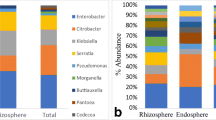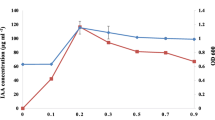Abstract
Recently, public concerns regarding the use of agrochemicals have increased due to the environmental impacts and potential risks to human health. The application of beneficial microorganisms is a novel technology to improve plant health and productivity and has therefore been extensively studied as an alternative strategy for biocontrol. In our study, 122 microbial isolates were obtained from the rhizosphere of Panax ginseng and subsequently tested in vitro for phosphate solubilization and indole acetic acid (IAA) production. Pikovskaya’s medium was used to estimate rhizomicrobial isolates to solubilize tricalcium phosphate [Ca3 (PO4)2]. Among all the investigated strains, 82 % of rhizospheric fungi showed phosphate solubilization activity; however, only 57.1 % of the rhizobacteria isolates showed phosphate solubilization ability. For IAA production, 64.7 % of the tested rhizofungi isolates were able to produce the phytohormone; however, only 47.62 % of the rhizobacteria isolates exhibited IAA production. Among all investigated species, Pseudomonas fluorescence and Azotobacter chroococcum showed the highest phosphate solubility demonstrating 885.4 and 863.4 μg mL−1, respectively. Mucor sp. produced 42.3 μg mL−1 of IAA in Czapek’s tryptophan medium, and the highest fungal species to solubilize the inorganic phosphate (237.5 μg mL−1) was estimated by Penicillium sp. Rhizobacteria were more effective than rhizofungi in phosphate solubilization and IAA production. This study introduces some potent species in terms of phosphate solubilization and IAA production which could be likely to improve soils’ quality and promote plant growth.




Similar content being viewed by others
References
Alam SS, Khalil NA, Rashid M (2002) In vitro solubilization of inorganic phosphate by phosphate solubilizing microorganisms (PSM) from maize rhizosphere. Int J Agric Biol 4:454–458
Atlas RM (2004) Handbook of microbiological media. CRC Press, Boca Raton
Brick JM, Bostock RM, Silversone SE (1991) Rapid in situ assay for indole acetic acid production by bacteria immobilized on nitrocellulose membrane. Appl Environ Microb 57:535–538
Cattelan AJ, Hartel PG, Fuhrmann JJ (1999) Screening for plant growth promoting rhizobacteria to promote early soybean growth. Soil Sci Soc Am J 63:1670–1680
Chen YP, Rekha PD, Arunshen AB, Lai WA, Young CC (2006) Phosphate solubilizing bacteria from subtropical soil and their tricalcium phosphate solubilizing abilities. Appl Soil Ecol 34:33–41
Dave Arti, Patel HH (2003) Impact of different carbon and nitrogen sources on phosphate solubilization by Pseudomonas fluorescens. Indian J Microbiol 43:33–36
De Freitas JR, Banerjee MR, Germida JJ (1997) Phosphate-solubilizing rhizobacteria enhance the growth and yield but not phosphorus uptake of cañóla (Brassica napus L.). Biol Fertil Soils 24:358–364
Domsch KH, Gams W, Anderson T (1980) Compendium of soil fungi, vol 1 and 2. Academic Press, London, pp 405–859
Dutton VM, Evans CS (1996) Oxalate production by fungi: its role in pathogenicity and ecology in the soil environment. Can J Microbiol 42:881–895
Frankenberger WT, Poth M (1988) l-Tryptophan transaminase of a bacterium isolated from the rhizosphere of Festuca octoflora (Graminae). Soil Biol Biochem 20:299–304
Glick BR (2012) Plant growth-promoting bacteria: mechanisms and applications. Hindawi Publishing Corporation, Scientifica
Glick BR, Changping L, Sibdas G, Dumbroff EB (1997) Early development of canola seedlings in the presence of the plant growth-promoting rhizobacterium Pseudomonas putida GR12-2. Soil Biol Biochem 29:1233–1239
Goldstein AH (1986) Bacterial solubilization of mineral phosphates: historical perspectives and future prospects. Am J Altern Agric 1:57–65
Goldstein AH (1994) Involvement of the quinoprotein glucose dehydrogenises in the solubilization of exogenous phosphates by gram-negative bacteria. In: Yagil E, Silver S, Torriani Gorini A (eds) Phosphate in microorganisms: cellular and molecular biology. ASM Press, Washington, DC, pp 197–203
Gordon SA, Weber RP (1951) Colorimetric estimation of indole acetic acid. Plant Physiol 26:192–195
Gürtler V, Stanisich VA (1996) New approaches to typing and identification of bacteria by using the 16S-23S rDNA spacer region. Microbiology 142:3–16
Hall JA, Pierson D, Ghosh S, Glick BR (1996) Root elongation in various agronomic crops by the plant growth promoting rhizobacterium Pseudomonas putida GR12-2. Isr J Plant Sc 44:37–42
Hayat R, Ali S, Amara U, Khalid R, Ahmed I (2010) Soil beneficial bacteria and their role in plant growth promotion: a review. Ann Microbiol 60:579–598
Holt JG (1986) Bergey’s manual of systematic bacteriology. In: Sneath PHA, Mair NS, Sharpe ME, Holt JG (eds) Gram-positive bacteria other than actino-mycetes. Williams & Williams, Baltimore
Hontzeas N, Saleh SS, Glick BR (2004) Changes in gene expression in canola roots by ACC deaminase-containing plant growth-promoting bacteria. Mol Plant Microbe Interact 17:865–871
Husen E (2003) Screening of soil bacteria for plant growth promotion activities in vitro. Indones J Agric Sci 4:27–31
Igual JM, Valverde A, Cervantes E, Velázquez E (2001) Phosphate-solubilizing bacteria as inoculants for agriculture: use of updated molecular techniques in their study. Agronomie 21:561–568
Kevin VJ (2003) Plant growth promoting rhizobacteria as biofertilizers. Plant Soil 255:571–585
Khan MS, Zaidi A, Ahmad E (2014) Mechanism of Phosphate Solubilization and Physiological Functions of Phosphate-Solubilizing Microorganisms. In: Khan MS, Zaidi A, Aamil M (eds) Phosphate Solubilizing Microorganisms. doi:10.1007/978-3-319-08216-5_2. © Springer International Publishing Switzerland 2014
Kim KY, Jordan D, Donald GAM (1998) Effect of phosphate-solubilizing bacteria and vesicular–arbuscular mycorrhizae on tomato growth and soil microbial activity. Biol Fertil Soils 26:79–87
Kloepper JW, Lifshitz R, Zablotowicz RM (1989) Free-living bacterial inocula for enhancing crop productivity. Trends Biotechnol 7:39–43
Kloepper JWE, Young S, Lifshitz R, Zablotowicz RM (1990) Description of a coryneyform plant growth promoting rhizobacteria (PGPR) strain and its effects on plant development. In: Klement AZ (ed) Plant pathogenic bacteria. Akademia, Kiado, pp 613–618
Moubasher AH (1993) Soil fungi in Qatar and other Arab countries. The Centre of Scientific and Applied Research, University of Qater, Doha, Qater
Patten C, Glick BR (1996) Bacterial biosynthesis of indole-3-acetic acid. Can J Microbiol 42:207–220
Pikovskaya RI (1948) Mobilization of phosphorus in soil connection with the vital activity of some microbial species. Microbiologiya 17:362–370
Ponmurugan P, Gopi C (2006) In vitro production of growth regulators and phosphate activity by phosphate solubilizing bacteria. Afr J Biotechnol 5:348–350
Pradhan N, Sukla LB (2005) Solubilization of inorganic phosphate by fungi isolated from agriculture soil. Afr J Biotechnol 5:850–854
Reyes I, Bernier L, Antoun H (2002) Rock phosphate solubilization and colonization of maize rhizosphere by wild and genetically modified strains of Penicillium rugulosum. Microb Ecol 44:39–48
Richardson AE (2001) Prospects for using soil micro-organisms to improve the acquisition of phosphorus by plants. Aust J Plant Physiol 28:897–906
Rodriguez H, Fraga R (1999) Phosphate solubilizing bacteria and their role in plant growth promotion. Biotechnol Adv 17:319–339
Rodríguez H, Goire I, Rodríguez M (1996) Caracterización de cepas de Pseudomonas solubilizadoras de fósforo. Rev ICIDCA 30:47–54
Sagoe CI, Ando T, Kouno K, Nagaoka T (1998) Relative importance of protons and solution calcium concentration in phosphate rock dissolution by organic acids. Soil Sci Plant Nutr 44:617–625
Seshadri S, Ignacimuthu S, Lakshminarsimhan C (2002) Variations in heterotrophic and phosphate solubilizing bacteria from Chennai, southeast coast of India. Indian J Mar Sci 31:69–72
Sharma K, Dak G, Agrawal A, Bhatnagar M, Sharma R (2007) Effect of phosphate solubilizing bacteria on the germination of Cicer arietinum seeds and seedling growth. J Herb Med Toxicol 1:61–63
Spaepen S, Vanderleyden J, Remans R (2007) Indole-3-acetic acid in microbial and microorganism- plant signaling. FEMS Microbiol Rev 31:1–24
Surange S, Wollum AG, Kumar N, Nautiyal CS (1995) Characterization of Rhizobium from root nodules of leguminous trees growing in alkaline soils. Can J Microbiol 43:891–894
Tomar US, Tomar IS, Badaya AK (1998) Response of chemical and biofertilizer on some matric traits in wheat. Crop Res Inst Hissar New Delhi 16:408–410
Turan M, Ataoglu N, Sahin F (2006) Evaluation of the capacity of phosphate solubilizing bacteria and fungi on different forms of phosphorus in liquid culture. J Sustain Agric 28:99–108
Vessey JK, Pawlowski K, Bergman B (2004) Root-based N2-fixing symbioses: legumes, actinorhizal plants, Parasponia sp. and cycads. Plant Soil 266:205–230
Whitelaw MA (2000) Growth promotion of plants inoculated with phosphate solubilizing fungi. Adv Agron 69:99–151
Xie H, Pasternak JJ, Glick BR (1996) Isolation and characterization of mutants of the plant growth-promoting rhizobacterium Pseudomonas putida GR12-2 that overproduce indoleacetic acid. Curr Microbiol 32:67–71
Yazdani M, Bahmanyar MA, Pirdashti H, Esmaili MA (2009) Effect of phosphate solubilization microorganisms (PSM) and plant growth promoting rhizobacteria (PGPR) on yield and yield components of Corn (Zea mays L.). Proc World Acad Sci Eng Technol 37:90–92
Acknowledgments
This study was supported by the National Research Foundation of Korean Government (Project Number: NRF-2013R1A1A2011950).
Author information
Authors and Affiliations
Corresponding author
Rights and permissions
About this article
Cite this article
Hussein, K.A., Joo, J.H. Isolation and characterization of rhizomicrobial isolates for phosphate solubilization and indole acetic acid production. J Korean Soc Appl Biol Chem 58, 847–855 (2015). https://doi.org/10.1007/s13765-015-0114-y
Received:
Accepted:
Published:
Issue Date:
DOI: https://doi.org/10.1007/s13765-015-0114-y




